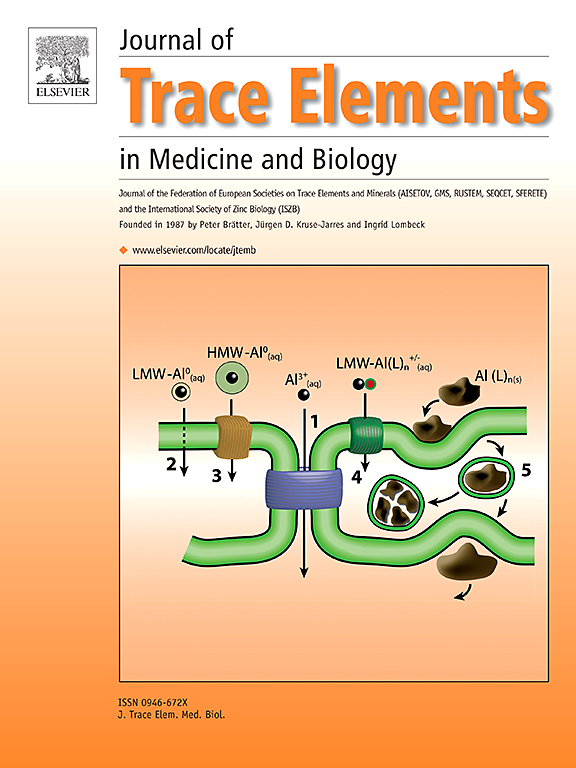Biometal concentrations, distribution and re-distribution in the thymus of healthy mice and mice with inflammatory arthritis
IF 3.6
3区 医学
Q2 BIOCHEMISTRY & MOLECULAR BIOLOGY
Journal of Trace Elements in Medicine and Biology
Pub Date : 2025-07-16
DOI:10.1016/j.jtemb.2025.127699
引用次数: 0
Abstract
Background and objective
Zinc, iron and copper are important for the proper functioning of the immune system. The thymus has a critical role in autoimmune diseases. However, data on concentrations and spatial distribution of metal ions in the thymus are limited. We therefore aimed to investigate the essential metals zinc, iron, and copper, and the non-essential metal nickel in the thymus of healthy mice and two transgenic murine models that develop inflammatory arthritis resembling rheumatoid arthritis, an autoimmune disease.
Methods
In slices of thymus tissues from wild-type, TNFΔAREhTNFR1KI (spondyloarthritis model), and Tg197hTNFR1KI (polyarthritis model) mice, total metal analyses were performed with inductively coupled plasma mass spectrometry while metal imaging was performed with laser ablation inductively coupled plasma mass spectrometry with novel quality control, standardization, and procedures for statistical evaluation.
Results
Total metal analyses revealed no difference in zinc, but an about twofold increase of copper in the thymi of the diseased mice. Total iron and nickel concentrations were also increased in the TNFΔAREhTNFR1KI mice. Imaging showed a seemingly homogeneous distribution of zinc, copper, and nickel in all mice, while iron was more concentrated near the medulla/cortex boundary in the wild-type and Tg197hTNFR1KI mice. Concentration frequency distribution histograms revealed shifts in concentration ranges in inflammation.
Conclusion
Combining metal analyses and metal imaging with concentration frequency distribution histograms uncovered changes of metals in the thymus of mice with inflammatory arthritis. These observations underpin future mechanistic studies of the role of metals in the immunology of the thymus’ involvement in arthritic disease.
健康小鼠和炎性关节炎小鼠胸腺的生物金属浓度、分布和再分布
背景与目的锌、铁和铜对免疫系统的正常运作很重要。胸腺在自身免疫性疾病中起着关键作用。然而,胸腺中金属离子的浓度和空间分布数据有限。因此,我们旨在研究健康小鼠胸腺中的必需金属锌、铁、铜和非必需金属镍,以及两种发生类似风湿性关节炎(一种自身免疫性疾病)的炎症性关节炎的转基因小鼠模型。方法对野生型、TNFΔAREhTNFR1KI(脊椎关节炎模型)和Tg197hTNFR1KI(多发性关节炎模型)小鼠胸腺组织切片,采用电感耦合等离子体质谱法进行全金属分析,采用激光消融电感耦合等离子体质谱法进行金属成像,并采用新颖的质量控制、标准化和统计评估程序。结果全金属分析显示,患病小鼠胸腺中锌含量无差异,而铜含量增加约两倍。TNFΔAREhTNFR1KI小鼠的总铁和总镍浓度也增加。在所有小鼠中,影像学显示锌、铜和镍的分布似乎均匀,而在野生型和Tg197hTNFR1KI小鼠中,铁更集中在髓质/皮层边界附近。浓度频率分布直方图显示炎症中浓度范围的变化。结论结合金属分析、金属成像和浓度频率分布直方图揭示了炎症性关节炎小鼠胸腺中金属的变化。这些观察结果为未来金属在胸腺参与关节炎疾病的免疫学中的作用机制研究奠定了基础。
本文章由计算机程序翻译,如有差异,请以英文原文为准。
求助全文
约1分钟内获得全文
求助全文
来源期刊
CiteScore
6.60
自引率
2.90%
发文量
202
审稿时长
85 days
期刊介绍:
The journal provides the reader with a thorough description of theoretical and applied aspects of trace elements in medicine and biology and is devoted to the advancement of scientific knowledge about trace elements and trace element species. Trace elements play essential roles in the maintenance of physiological processes. During the last decades there has been a great deal of scientific investigation about the function and binding of trace elements. The Journal of Trace Elements in Medicine and Biology focuses on the description and dissemination of scientific results concerning the role of trace elements with respect to their mode of action in health and disease and nutritional importance. Progress in the knowledge of the biological role of trace elements depends, however, on advances in trace elements chemistry. Thus the Journal of Trace Elements in Medicine and Biology will include only those papers that base their results on proven analytical methods.
Also, we only publish those articles in which the quality assurance regarding the execution of experiments and achievement of results is guaranteed.

 求助内容:
求助内容: 应助结果提醒方式:
应助结果提醒方式:


